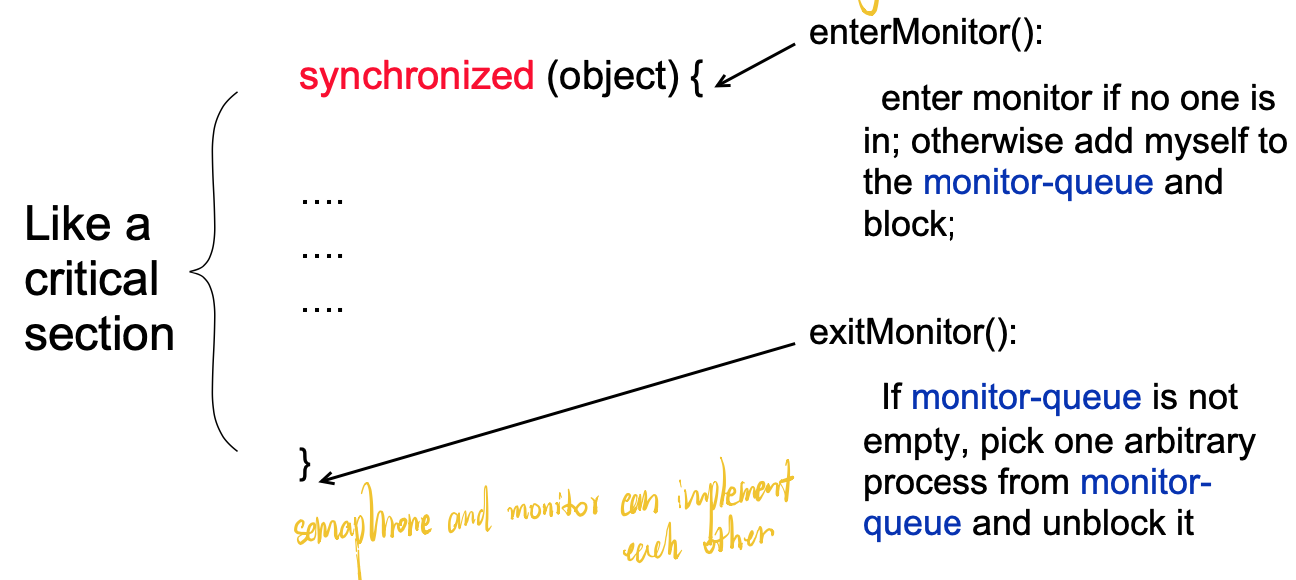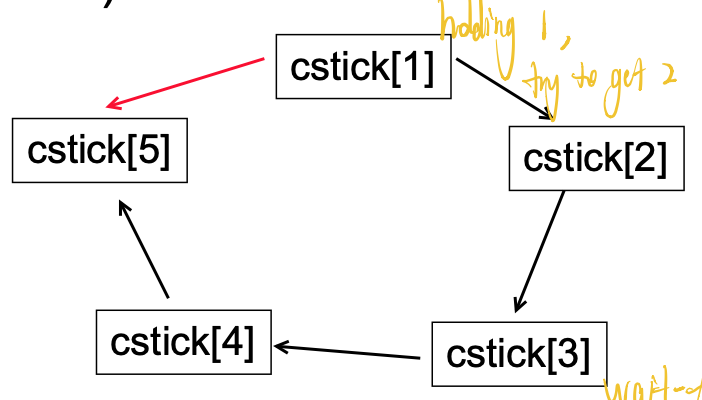Synchronization Primitives
Why do we need synchronization primitives?
To deal with busy wait problem
Synchronization Primitives
OS-level APIs that the program may call
- Semaphores
- Monitors
Semaphores
Internally, each semaphores has
- A boolean value - initially true
- A queue of blocked processes - initially empty
P():
if (value == false) {
add myself to queue and block;
}
value = false;
V():
value = true;
if (queue is not empty) {
wake up one arbitrary process on the queue
}
The functions are executed atomically
Exactly one process is waken up in V()
Using Semaphore for Mutual Exclusion
RequestCS() {P();}
ReleaseCS() {V();}
No busy waiting
Monitors
Higher level compared to semaphore.
Java only has monitors. Every object in Java is a monitor (has a monitor lock)
Each monitor has two queues of blocked processes
-
monitor-queue
A queue of threads waiting for the lock associated with the monitor
-
wait-queue
A queue of threads waiting for some condition to become true
Java does not have condition variables. Associated with each object there is a single wait queue for conditions

There are 3 special methods for using when inside a monitor:
object.wait(): Add myself to the wait-queue, exit monitor and then block
object.notify(): If wait-queue is not empty, pick one arbitrary process from wait-queue and unblock it
object.notifyAll(): If wait-queue is not empty, unblock all processes in wait-queue
Two kinds of monitors
P0: object.wait()
P1: object.notify()
Hoare-style Monitor
P0 takes over the execution
One of the threads that was waiting on the condition variable continues execution.
Advantage
The thread that was notified on the condition starts its execution without intervention of any other thread
On waking up, it can assume that the condition is true
if (!B) x.wait();
Java-style Monitor
P1 takes over the execution
The thread that made the notify call continues its execution.
while (!B) x.wait();
No need to do context switch, more popular
Other Ways of Using Monitors in Java
public synchronized void myMethod() {}
=
public void myMethod() {
synchronized(this) {}
}
Static methods can also be synchronized - the monitor clock is class wide
Nested Monitor in Java
synchronized(ObjA) {
synchronized(ObjB) {
ObjB.wait(); // Here Java only realeases the monitor lock on ObjB and not the monitor lock on ObjA
}
}
// Will not be able to get the monitor lock of ObjA
synchronized(ObjA) { // This piece of code will block and will not reach ObjB.notify() - deadlock!
synchronized(ObjB) {
ObjB.notify();
}
}
Dining Philosopher Problem (Dijkstra’65)
It’s useful in bringing out issues associated with concurrent programming and symmetry.
Avoid deadlock
=> Avoid cycles or have a total ordering of the chopsticks
- Requiring one of the philosophers to grab forks in a different order
- Requiring philosophers to grab both the forks at the same time
- Assume that a philosopher has to stand before grabbing any fork. Allow at most four philosophers to be standing at any given time.


This is called a wait-for graph, we use it to check if there is a cycle
In this graph, vertex is representing resources.
The Producer-Consumer Problem
A circular buffer of size $n$ in which $inBuf$ and $outBuf$ are incremented modulo $size$ to keep track of the slots for depositing and fetching items.
A single producer and a single consumer
Conditional Synchronization
It requires a process to wait for some condition to become true (such as the buffer to become non-empty), before continuing its operations
Why circular buffer?
- Producer and consumer speed is different
- Producer and consumer speed is not constant
void produce() {
synchronized(sharedBuffer) {
while(sharedBuffer is full) { // if there is only one producer, can use if
sharedBuffer.wait(); // when returning from wait(), sharedBuffer can be full again (different from P())
}
boolean bufferWasEmpty = buffer.isEmpty();
add an item to buffer;
if (bufferWasEmpty)
sharedBuffer.notify() // notification is lost if no process is waiting (different from V())
}
}
void consume() {
synchronized(sharedBuffer) {
while(sharedBuffer is empty) {
sharedBuffer.wait();
}
boolean bufferWasFull = buffer.isFull()
remove an item from buffer;
if (bufferWasFull)
sharedBuffer.notify();
}
}
The Reader-Writer Problem
Multiple readers and writers are accessing a database
A writer must have exclusive access
But readers may simultaneously access the database
void writeDB() {
synchronized(object) {
while(numReader > 0 || numWriter > 0)
object.wait();
numWriter = 1;
}
// write to DB
synchronized(object) {
numWriter = 0;
object.nofityAll(); // becasue there can be many readers blocked
}
}
void readDB() {
synchronized(object) {
while(numWriter > 0) // must be while
object.wait();
numReader++;
}
// read from DB
synchronized(object) {
numReader--;
object.notify(); // it must be a writer notified, can change to notifyAll() to wake up all writers, but only one of them can have the monitor lock
}
}
The Starvation Problem
Writers may get starved if there is a continuous stream of readers, because numReader will not drop to 0